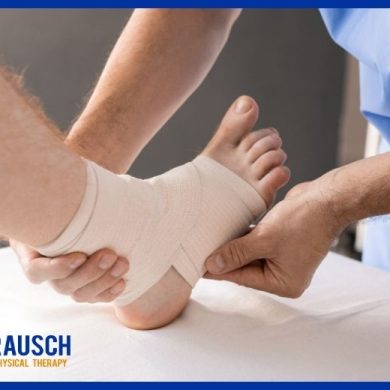At Rausch Physical Therapy and Wellness, we believe that movement is medicine—at every age and every stage of life. That’s why we’re excited to announce our new partnership with Fort Fitness,
Physical Therapy After Fracture
September 19, 2019 1:19 pm / Category: Dana Point , Uncategorized
If you have suffered a broken bone, also known as a fracture, then you may benefit from the skilled services of a physical therapist. Your physical therapist can help you regain normal range of motion, strength, and functional mobility after a fracture. So what does physical therapy and rehab entail after a fracture?
If you have had the unfortunate injury of a fracture or broken bone, then you may understand how painful this can be. A broken bone requires swift medical attention to ensure proper healing and alignment of the bone.
After a fracture, your bone will be set, or reduced, by a doctor. Reduction of the bone can be done manually. For more serious fractures, a surgical procedure called an open reduction internal fixation (ORIF) may be necessary to make sure that all the bone pieces are in the correct place and healing can occur.
Often after fracture, the bone needs to be stabilized or immobilized to ensure proper healing. This is usually accomplished using a cast. For simple fractures, your doctor may elect to apply a removable cast so that gentle motion can occur around the injury site. After complex fractures or an ORIF procedure, you may be required to wear a cast that is not to be removed. If you fracture your shoulder or arm, you may be required to wear a sling to keep the arm immobilized. Check with your doctor to ensure that you understand what is expected of you in regard to immobilization.
Starting Physical Therapy after Fracture
After a fracture, physical therapy may be ordered to help ensure you return to optimum function as quickly as possible. You may encounter a physical therapist at different times in the continuum of care after suffering a fracture.
In the Hospital
After you fracture a bone, a physical therapist may visit you in the hospital. If you break your leg or ankle, a physical therapist may instruct you in how to walk with an assistive device, like a cane or crutches. This includes how to use the device to walk up and down stairs or to get into and out of a car. Be sure to ask questions if you have any.
After a lower extremity fracture, your doctor may limit the amount of weight you can put on your leg. Your PT can help you understand weight bearing restrictions and can teach you how to move about while still maintaining these restrictions.
If you fracture your arm, you may be required to keep your arm in a sling to help with healing. In the hospital, your physical therapist may teach you how to apply and remove the sling.
At Home
When you return home from the hospital after a fracture, your doctor may order physical therapy at home. Home care physical therapy usually is reserved for people who are unable to leave the house as a result of their injury.
Your physical therapist can help you master using your assistive device in your home environment. You may also engage in exercises to help improve your overall endurance or to strengthen the muscles around the fracture site.
If you break your leg or ankle, your doctor may have specific weight-bearing restrictions that you must follow. Your physical therapist can help you maintain these restrictions to ensure that you do not put too much stress on the healing bone. Lifting restrictions may be in place after an arm or shoulder fracture. At your house, your physical therapist can also assess your home environment. He or she can make recommendations to make minor adjustments to allow you to move safely around your home.
If surgery was required to set your fracture, your PT may assess your surgical scar to ensure that things are healing properly.
In the Clinic
When you have recovered enough to travel from your home, your doctor may refer you to a physical therapy clinic to help with restoring normal function after your fracture. Usually, this occurs after the cast has been removed and you can start mobilizing the area around the fracture. You may still have to follow weight-bearing precautions or lifting restrictions at this point, so be sure to consult with your doctor so you understand what your limitations are.
Your first visit with your physical therapist will usually involve an evaluation and assessment. Your therapist will likely take measurements of body parts around the fracture site. This might include measurements of:
- Range of motion
- Strength
- Pain
- Flexibility
- Girth or swelling
- Gait (for lower extremity fractures)
- Overall function and mobility
After the initial evaluation, your physical therapist can work with you to devise a treatment strategy to help you recover fully. Physical therapy after a fracture often focuses on overcoming the negative effects of being immobilized by a cast or sling. Immobilization may cause loss of motion and strength and decreased functional mobility.
Physical therapy after fracture can also help you improve your functional mobility. If you have fractured your leg, your physical therapist can help you improve walking and help decide if you should walk with a walker, crutches, quad cane, or standard cane. If you have fractured an arm or shoulder, functional activities that focus on reaching and grasping may be included.
Physical agents or modalities may be used to help with pain and swelling. Electrical stimulation may also be used to help improve muscle recruitment. You should remember that while passive treatments like electrical stimulation or ultrasound may be used, you should also be engaged in active activities in your physical therapy.
If you have had surgery to reduce the fractured bone, you may have surgical scar tissue. Scar massage and mobilization can help reduce scar adhesions and improve mobility around the scar.
Exercises to improve range of motion and strength may also be started. Particular focus should be placed on the fractured area and the joints around the fracture. If you broke a bone near your elbow, mobility exercises should be included for your elbow, wrist, and shoulder. Likewise, a fracture of the tibia (shin) should include exercises for the knee, ankle, and hip.
How Long Should PT Last?
Everyone’s fracture is different, and everyone heals at different rates. In general, a fracture should be healed by about eight weeks, and you should be back to normal within 12 weeks of a fracture. Your rehab should normally take about six to eight weeks, but your program may be slightly shorter or longer. Your physical therapist should be able to give you an idea of how long your rehab program is expected to last.
If you find yourself in discomfort or think you could benefit from a personalized exercise plan, talk to a
Physical Therapist.
Let’s talk! We are here to help. Give us a call for a complimentary assessment.
Did you know there’s no prescription needed from a doctor to see us?
(949) 443-0713
{Reference: https://www.verywellhealth.com/physical-therapy-after-fracture-2696424}






